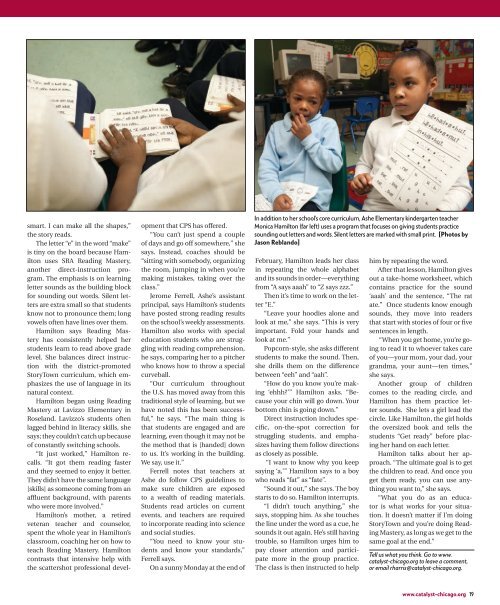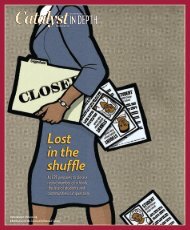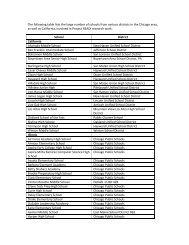The ABCs of kindergarten - catalyst-chicago.org
The ABCs of kindergarten - catalyst-chicago.org
The ABCs of kindergarten - catalyst-chicago.org
You also want an ePaper? Increase the reach of your titles
YUMPU automatically turns print PDFs into web optimized ePapers that Google loves.
smart. I can make all the shapes,”<br />
the story reads.<br />
<strong>The</strong> letter “e” in the word “make”<br />
is tiny on the board because Hamilton<br />
uses SRA Reading Mastery,<br />
another direct-instruction program.<br />
<strong>The</strong> emphasis is on learning<br />
letter sounds as the building block<br />
for sounding out words. Silent letters<br />
are extra small so that students<br />
know not to pronounce them; long<br />
vowels <strong>of</strong>ten have lines over them.<br />
Hamilton says Reading Mastery<br />
has consistently helped her<br />
students learn to read above grade<br />
level. She balances direct instruction<br />
with the district-promoted<br />
StoryTown curriculum, which emphasizes<br />
the use <strong>of</strong> language in its<br />
natural context.<br />
Hamilton began using Reading<br />
Mastery at Lavizzo Elementary in<br />
Roseland. Lavizzo’s students <strong>of</strong>ten<br />
lagged behind in literacy skills, she<br />
says; they couldn’t catch up because<br />
<strong>of</strong> constantly switching schools.<br />
“It just worked,” Hamilton recalls.<br />
“It got them reading faster<br />
and they seemed to enjoy it better.<br />
<strong>The</strong>y didn’t have the same language<br />
[skills] as someone coming from an<br />
affluent background, with parents<br />
who were more involved.”<br />
Hamilton’s mother, a retired<br />
veteran teacher and counselor,<br />
spent the whole year in Hamilton’s<br />
classroom, coaching her on how to<br />
teach Reading Mastery. Hamilton<br />
contrasts that intensive help with<br />
the scattershot pr<strong>of</strong>essional development<br />
that CPS has <strong>of</strong>fered.<br />
“You can’t just spend a couple<br />
<strong>of</strong> days and go <strong>of</strong>f somewhere,” she<br />
says. Instead, coaches should be<br />
“sitting with somebody, <strong>org</strong>anizing<br />
the room, jumping in when you’re<br />
making mistakes, taking over the<br />
class.”<br />
Jerome Ferrell, Ashe’s assistant<br />
principal, says Hamilton’s students<br />
have posted strong reading results<br />
on the school’s weekly assessments.<br />
Hamilton also works with special<br />
education students who are struggling<br />
with reading comprehension,<br />
he says, comparing her to a pitcher<br />
who knows how to throw a special<br />
curveball.<br />
“Our curriculum throughout<br />
the U.S. has moved away from this<br />
traditional style <strong>of</strong> learning, but we<br />
have noted this has been successful,”<br />
he says. “<strong>The</strong> main thing is<br />
that students are engaged and are<br />
learning, even though it may not be<br />
the method that is [handed] down<br />
to us. It’s working in the building.<br />
We say, use it.”<br />
Ferrell notes that teachers at<br />
Ashe do follow CPS guidelines to<br />
make sure children are exposed<br />
to a wealth <strong>of</strong> reading materials.<br />
Students read articles on current<br />
events, and teachers are required<br />
to incorporate reading into science<br />
and social studies.<br />
“You need to know your students<br />
and know your standards,”<br />
Ferrell says.<br />
On a sunny Monday at the end <strong>of</strong><br />
In addition to her school’s core curriculum, Ashe Elementary <strong>kindergarten</strong> teacher<br />
Monica Hamilton (far left) uses a program that focuses on giving students practice<br />
sounding out letters and words. Silent letters are marked with small print. [Photos by<br />
Jason Reblando]<br />
February, Hamilton leads her class<br />
in repeating the whole alphabet<br />
and its sounds in order—everything<br />
from “A says aaah” to “Z says zzz.”<br />
<strong>The</strong>n it’s time to work on the letter<br />
“E.”<br />
“Leave your hoodies alone and<br />
look at me,” she says. “This is very<br />
important. Fold your hands and<br />
look at me.”<br />
Popcorn-style, she asks different<br />
students to make the sound. <strong>The</strong>n,<br />
she drills them on the difference<br />
between “eeh” and “aah”.<br />
“How do you know you’re making<br />
‘ehhh?’” Hamilton asks. “Because<br />
your chin will go down. Your<br />
bottom chin is going down.”<br />
Direct instruction includes specific,<br />
on-the-spot correction for<br />
struggling students, and emphasizes<br />
having them follow directions<br />
as closely as possible.<br />
“I want to know why you keep<br />
saying ‘a,’” Hamilton says to a boy<br />
who reads “fat” as “fate”.<br />
“Sound it out,” she says. <strong>The</strong> boy<br />
starts to do so. Hamilton interrupts.<br />
“I didn’t touch anything,” she<br />
says, stopping him. As she touches<br />
the line under the word as a cue, he<br />
sounds it out again. He’s still having<br />
trouble, so Hamilton urges him to<br />
pay closer attention and participate<br />
more in the group practice.<br />
<strong>The</strong> class is then instructed to help<br />
him by repeating the word.<br />
After that lesson, Hamilton gives<br />
out a take-home worksheet, which<br />
contains practice for the sound<br />
‘aaah’ and the sentence, “<strong>The</strong> rat<br />
ate.” Once students know enough<br />
sounds, they move into readers<br />
that start with stories <strong>of</strong> four or five<br />
sentences in length.<br />
“When you get home, you’re going<br />
to read it to whoever takes care<br />
<strong>of</strong> you—your mom, your dad, your<br />
grandma, your aunt—ten times,”<br />
she says.<br />
Another group <strong>of</strong> children<br />
comes to the reading circle, and<br />
Hamilton has them practice letter<br />
sounds. She lets a girl lead the<br />
circle. Like Hamilton, the girl holds<br />
the oversized book and tells the<br />
students “Get ready” before placing<br />
her hand on each letter.<br />
Hamilton talks about her approach.<br />
“<strong>The</strong> ultimate goal is to get<br />
the children to read. And once you<br />
get them ready, you can use anything<br />
you want to,” she says.<br />
“What you do as an educator<br />
is what works for your situation.<br />
It doesn’t matter if I’m doing<br />
StoryTown and you’re doing Reading<br />
Mastery, as long as we get to the<br />
same goal at the end.”<br />
Tell us what you think. Go to www.<br />
<strong>catalyst</strong>-<strong>chicago</strong>.<strong>org</strong> to leave a comment,<br />
or email rharris@<strong>catalyst</strong>-<strong>chicago</strong>.<strong>org</strong>.<br />
www.<strong>catalyst</strong>-<strong>chicago</strong>.<strong>org</strong> 19









